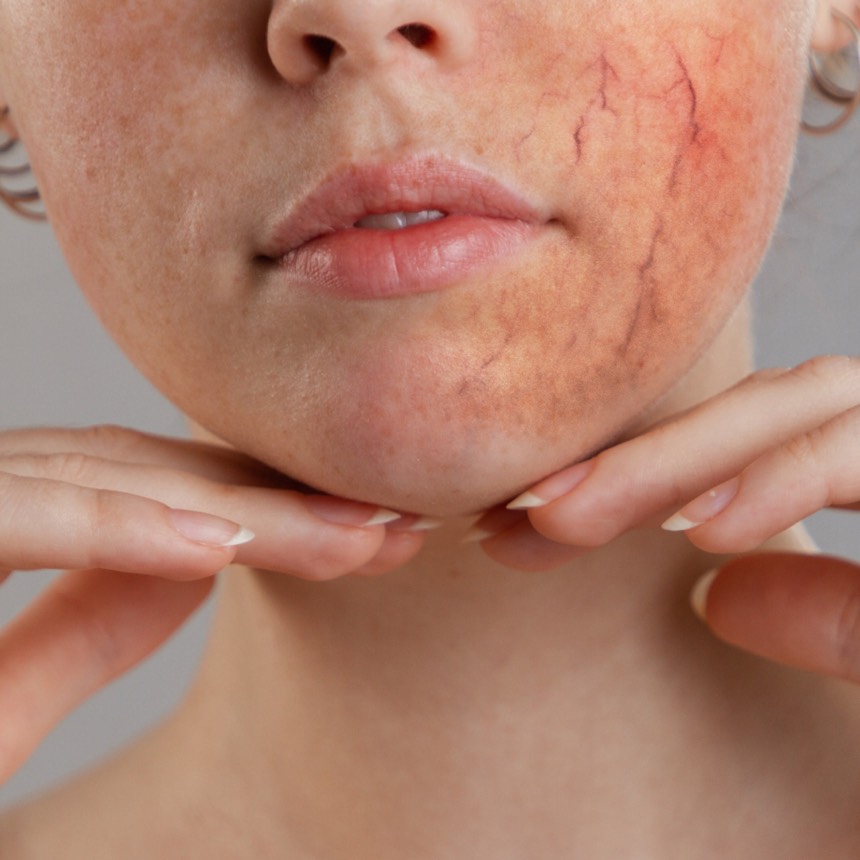Understanding and Managing Broken Capillaries on the Face
Broken capillaries are a common skin condition that can affect individuals of all ages. Broken capillaries, also known as spider veins or telangiectasias, are tiny blood vessels that become visible near the surface of the skin. They are most commonly found on the face, particularly around the nose, cheeks, and chin. Often appearing as red, web-like patterns, While they are generally harmless, they can be a cosmetic concern for many people. This blog post will guide you through the causes of broken capillaries, tips for prevention, and the most effective treatments to reduce their appearance.
What are the causes of Broken Capillaries?
There are several factors that can contribute to the appearance of broken capillaries:
- If you have a family history of broken capillaries, you would have a higher chance of developing them.
- Too much sun exposure can weaken blood vessels and cause them to become more visible.
- As we age, our skin becomes thinner and blood vessels can become more prominent.
- Aggressive facial treatments, harsh scrubbing, or physical injuries can damage capillaries.
- Extreme weather conditions, such as cold winds or hot, dry climates, can exacerbate the appearance of broken capillaries.
- Excessive alcohol can dilate blood vessels, making them more visible over time.
- Conditions like rosacea can cause chronic inflammation and lead to broken capillaries.

How can you prevent getting broken capillaries?
We know you can’t change your genetic predisposition, but there are several steps you can take to minimize the risk of developing broken capillaries:
- Always have good sun protection, like using a broad-spectrum sunscreen with at least SPF 30, wearing hats, and seeking shade when the sun is strongest.
- Use gentle skincare products, avoid harsh exfoliants and aggressive facial treatments.
- Limit alcohol intake can help prevent the dilation of blood vessels.
- Protect your skin in extreme weather conditions, use protective skincare and clothing to shield your face from damage.
- Maintain a healthy diet, exercise regularly, and avoid smoking to promote overall skin health.
What are the treatments for treating broken capillaries?
If you already have broken capillaries, several treatments can help reduce their appearance:
- Laser treatments target and break down the blood vessels, causing them to be reabsorbed by the body. This is a popular and effective option.
- Intense Pulsed Light (IPL) treatments use broad-spectrum light to target and reduce the appearance of broken capillaries.
- Certain topical creams and serums containing ingredients like vitamin K and arnica can help strengthen blood vessels and reduce redness.
- Mild chemical peels can improve the overall texture and appearance of the skin, making broken capillaries less noticeable.
- Microneedling can help stimulate collagen production and improve the skin’s appearance, though it should be done cautiously to avoid further damage.
Conclusion
Broken capillaries on the face can be a cosmetic concern, but understanding their causes and taking preventive measures can help minimize their occurrence. For those already dealing with this issue, various effective treatments are available to reduce their appearance and improve skin health. Always consult with a skincare professional to determine the best course of action for your specific needs. At Invigorate Spa, we offer a range of treatments and products to help you achieve clear, radiant skin. Contact us today to learn more about how we can help you manage and treat broken capillaries.
Our contact info: Invigorate Spa 4825 E 96th St. STE 500, Indy Website: www.invigoratespa.com Call/Text: 317-688-7275
Book your appointment today to explore our advanced skincare treatments and let us help you achieve the clear, beautiful skin you deserve!
